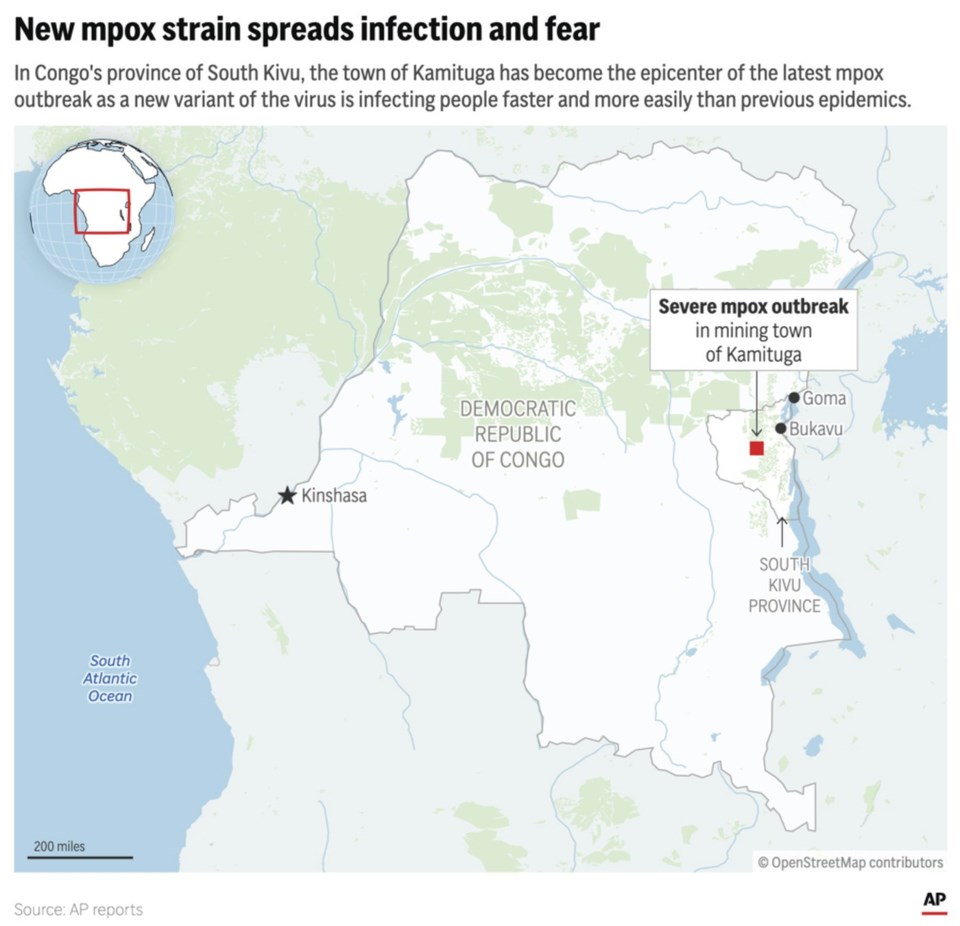KAVUMU, Congo (AP) — Health authorities have struggled to contain outbreaks of mpox in Congo, a huge central African country where a myriad of existing problems makes stemming the spread particularly hard.
Last month, the World Health Organization declared the outbreaks in Congo and about a dozen other African countries a global health emergency. And in Congo, scientists have identified a new strain of mpox that may spread more easily. It has reached areas where conflict and the displacement of a large number of people have already put health services under pressure.
Overall, Congo has more than 21,000 of the 25,093 confirmed and suspected mpox cases in Africa this year, according to WHO's most recent count.
Has Congo seen cases of mpox before?
Yes, Congo is one of the African countries where mpox has been endemic for decades.
Mpox, once known as monkeypox, comes from the same family of viruses as smallpox but causes milder symptoms such as fever. People with more serious cases can develop skin lesions. More than 720 people in Africa have died in the latest outbreaks, mostly in Congo.
Mpox is a zoonotic disease, meaning it can spread to humans from infected animals. In the global mpox outbreak of 2022, the virus spread between people primarily through sex and close physical contact.
What changed in Congo?
In September 2023, mpox spread to Congo's eastern province of South Kivu; it had previously been seen in the center and far west. Scientists then identified a new form of mpox in South Kivu that may be more infectious.
The WHO said that from the outbreak in South Kivu, the virus spread among people elsewhere in the country, arriving in neighboring province North Kivu. Those two provinces — some 2,000 kilometers (1,240 miles) from the capital, Kinshasa — face escalating violence, a humanitarian crisis and other issues.
What are the problems in eastern Congo?
More than 120 armed groups have been fighting each other and the Congolese army for years in the eastern part of the country over the control of minerals. That has forced millions of people fleeing violence into refugee camps or nearby towns.
That means mpox is hitting already-stretched health facilities. Dr. Musole Mulambamunva Robert, medical director of the Kavumu hospital in eastern Congo, said it is “truly a challenge” — sometimes treating as many as four times the facility's capacity for patients.
With more than 6 million displaced people in the east, authorities and aid agencies were already struggling to provide food and healthcare, while fighting other diseases such as cholera. Many people have no access to soap, clean water or other basics.
Some eastern Congo communities are out of reach of health clinics — roads are unreliable, and hourslong risky boat trips are sometimes the only means of transport, said Mercy Muthee Lake of the International Federation of Red Cross and Red Crescent.
People can be more susceptible to severe mpox cases because of malnutrition and undiagnosed HIV, she said.
She also said health workers in eastern Congo have requested more mpox training as medications to treat fever and ease pain run out.
Health authorities "are up against it because it’s such a complex area,” said Chris Beyrer, of Duke University’s Global Health Institute.
What about vaccines?
Africa has no capacity to produce mpox vaccines. Around 250,000 doses have arrived in Congo from the European Union and the United States, and more are expected. Congolese authorities say they need around 3 million vaccines. It will likely be weeks before any vaccines reach people in eastern Congo.
For now, the vaccine is approved only for adults. There's limited evidence of how it works in children.
Vaccines are desperately needed, but they're just “an additional tool,” said Emmanuel Lampaert, the Congo representative for Doctors Without Borders. The key, Lampaert said, is still identifying cases, isolating patients, and executing grassroots health and education campaigns.
Local conditions make that trying — Lampaert noted it's almost impossible to isolate cases among poor, displaced people.
“Families with six to eight children are living in a hut, which is maybe the space of the bed we are sleeping in,” he said. “So, this is the reality.”
Why are critics blasting the mpox response?
Unlike the millions of dollars that poured into Congo for Ebola and COVID aid, the response to mpox has been sluggish, many critics say.
Health experts say the sharp contrast is due to a lack of both funds and international interest.
“Ebola is the most dangerous virus in the world, and COVID wiped out the world economy,” said professor Ali Bulabula, who works on infectious diseases in the medical department at Congo’s University of Kindu. “While mpox is a public health emergency of international concern, there is a lack of in-depth research and interest in the virus, as it’s still seen as a tropical disease, localized to Africa with no major impact on Western economies.”
___
Asadu reported from Abuja, Nigeria, and Imray reported from Cape Town, South Africa. AP reporter Sam Mednick contributed from Kamituga, Congo.
___
For more news on Africa and development: https://apnews.com/hub/africa-pulse
___
The Associated Press receives financial support for global health and development coverage in Africa from the Gates Foundation. The AP is solely responsible for all content. Find AP’s standards for working with philanthropies, a list of supporters and funded coverage areas at AP.org.
Ruth Alonga, Chinedu Asadu And Gerald Imray, The Associated Press


